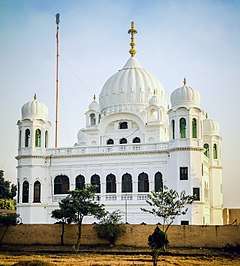Guru Nanak
Guru Nanak (Punjabi: ਗੁਰੂ ਨਾਨਕ (Gurmukhi); گرو نانک (Shahmukhi); Gurū Nānak; [gʊɾuː naːnəkᵊ], ![]()
Guru Nanak | |
|---|---|
ਗੁਰੂ ਨਾਨਕ | |
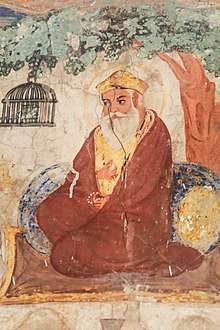 19th century mural painting from Gurdwara Baba Atal depicting Nanak | |
| Personal | |
| Born | Nanak 15 April 1469 |
| Died | 22 September 1539 (aged 70) |
| Resting place | Gurdwara Darbar Sahib Kartar Pur, Kartarpur, Pakistan |
| Religion | Sikhism |
| Spouse | Mata Sulakhani |
| Children | Sri Chand, Lakhmi Das |
| Parents | Mehta Kalu and Mata Tripta |
| Known for | Founder of Sikhism |
| Religious career | |
| Successor | Guru Angad |
| Part of a series on |
| Sikhism |
|---|
 |
|
|
Practices
|
|
|
General topics
|
Nanak is said to have travelled far and wide across Asia teaching people the message of ik onkar (ੴ, 'one God'), who dwells in every one of his creations and constitutes the eternal Truth.[2] With this concept, he would set up a unique spiritual, social, and political platform based on equality, fraternal love, goodness, and virtue.[3][4][5]
Nanak's words are registered in the form of 974 poetic hymns, or shabda, in the holy text of Sikhism, the Guru Granth Sahib, with some of the major prayers being the Japji Sahib (jap, 'to recite'; ji and sahib are suffixes signifying respect); the Asa di Var ('ballad of hope'); and the Sidh Gohst ('discussion with the Siddhas'). It is part of Sikh religious belief that the spirit of Nanak's sanctity, divinity, and religious authority had descended upon each of the nine subsequent Gurus when the Guruship was devolved on to them.[6]
Biography
Birth
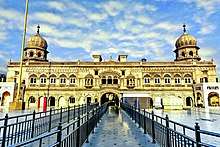
Nanak was born on 15 April 1469 at Rāi Bhoi Kī Talvaṇḍī village (present-day Nankana Sahib, Punjab, Pakistan) in the Lahore province of the Delhi Sultanate,[7][8] although according to one tradition, he was born in the Hindu month of Kartik (November; known later as Katak in Sikhism).[9]
Most janamsakhis (ਜਨਮਸਾਖੀ, 'birth stories')—the traditional biographies of Nanak—mention that he was born on the third day of the bright lunar fortnight, in the Baisakh month (April) of Samvat 1526.[9] These include the Puratan ('traditional' or 'ancient') janamsakhi, Miharban janamsakhi, Gyan-ratanavali by Bhai Mani Singh, and the Vilayat Vali janamsakhi.[10] The Sikh records state that Nanak died on the 10th day of the Asauj month of Samvat 1596 (22 September 1539 CE), at the age of 70 years, 5 months, and 7 days. This further suggests that he was born in the month of Baisakh (April), not Kartik (November).[11]
Kartik birthdate
In as late as 1815, during the reign of Ranjit Singh, the festival commemorating Nanak's birthday was held in April at the place of his birth, known by then as Nankana Sahib.[10] However, the anniversary of Nanak's birth—the Gurpurab (guru + purab, 'celebration')—subsequently came to be celebrated on the full moon day of the Kartik month in November. The earliest record of such a celebration in Nanakana Sahib is from 1868 CE.[12]
There may be several reasons for the adoption of the Kartik birthdate by the Sikh community. For one, it may have been the date of Nanak's enlightenment or "spiritual birth" in 1496, as suggested by the Dabestan-e Mazaheb.
The only janamsakhi that supports the Kartik birth tradition is that of Bhai Bala. Bhai Bala is said to have obtained Nanak's horoscope from Nanak's uncle Lalu, according to which, Nanak was born on a date corresponding to 20 October 1469 CE. However, this janamsakhi was written by Handalis—a sect of Sikhs who followed a Sikh-convert known as Handal—attempting to depict the founder as superior to Nanak.[13] According to a superstition prevailing in contemporary northern India, a child born in the Kartik month was believed to be weak and unlucky, hence why the work states that Nanak was born in that month.[13]
Bhai Gurdas, having written on a full-moon-day of the Kartik month several decades after Nanak's death, mentions that Nanak had "obtained omniscience" on the same day, and it was now the author's turn to "get divine light."[14]
According to Max Arthur Macauliffe (1909), a Hindu festival held in the 19th century on Kartik Purnima in Amritsar attracted a large number of Sikhs. The Sikh community leader Giani Sant Singh did not like this, thus starting a festival at the Sikh shrine of the Golden Temple on the same day, presenting it as the birth anniversary celebration of Guru Nanak.[15]
Macauliffe also notes that Baisakh (March–April) already saw a number of important festivals—such as Holi, Rama Navami, and Baisakhi—therefore people would be busy in agricultural activities after the harvest festival of Baisakhi. Therefore, holding Nanak's birth anniversary celebrations immediately after Baisakhi would have resulted in thin attendance, and therefore, smaller donations for the Sikh shrines. On the other hand, by the Kartik full moon day, the major Hindu festival of Diwali was already over, and the peasants—who had surplus cash from crop sales—were able to donate generously.[16]
Family and early life
Nanak's parents, including father Kalyan Chand Das Bedi (commonly shortened to Mehta Kalu) and mother Mata Tripta,[17] were both Hindu Khatris and employed as merchants.[18][19] His father, in particular, was the local patwari (accountant) for crop revenue in the village of Talwandi.[20]
According to Sikh traditions, the birth and early years of Nanak's life were marked with many events that demonstrated that Nanak had been blessed with divine grace.[21] Commentaries on his life give details of his blossoming awareness from a young age. For instance, at the age of five, Nanak is said to have voiced interest in divine subjects. At age seven, his father enrolled him at the village school, as per custom.[22] Notable lore recounts that, as a child, Nanak astonished his teacher by describing the implicit symbolism of the first letter of the alphabet, resembling the mathematical version of one, as denoting the unity or oneness of God.[23] Other stories of his childhood refer to strange and miraculous events about Nanak, such as the one witnessed by Rai Bular, in which the sleeping child's head was shaded from the harsh sunlight by, in one account, by the stationary shadow of a tree or, in another, by a venomous cobra.[24]
Nanaki, Nanak's one and only sister, was five years older than him. In 1475, she married and moved to Sultanpur. Jai Ram, Nanaki's husband, was employed at a modikhana (a storehouse for revenues collected in non-cash form), in the service of the Delhi Sultanate's Lahore governor Daulat Khan, at which Ram would help Nanak get a job.[26] Nanak moved to Sultanpur, and started working at the modikhana around the age of 16.
As a young man,[lower-roman 1] Nanak married Sulakhani, daughter of Mūl Chand (aka Mula)[lower-roman 2][lower-roman 3] and Chando Raṇi. They were married on 24 September 1487, in the town of Batala,[27] and would go on to have two sons, Sri Chand and Lakhmi Chand[26] (or Lakhmi Das).[lower-roman 4][28] Nanak lived in Sultanpur until c. 1500,[26] which would be a formative time for him, as the puratan janamsakhi suggests, and in his numerous allusions to governmental structure in his hymns, most likely gained at this time.[29]
Final years
Around the age of 55, Nanak settled in Kartarpur, living there until his death in September 1539. During this period, he went on short journeys to the Nath yogi centre of Achal, and the Sufi centres of Pakpattan and Multan. By the time of his death, Nanak had acquired several followers in the Punjab region, although it is hard to estimate their number based on the extant historical evidence.[30]
Guru Nanak appointed Bhai Lehna as the successor Guru, renaming him as Guru Angad, meaning "one's very own" or "part of you". Shortly after proclaiming his successor, Guru Nanak died on 22 September 1539 in Kartarpur, at the age of 70.[31]

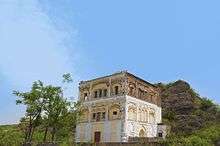
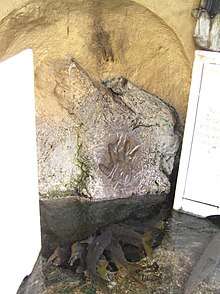

Journeys (Udasis)
During first quarter of the 16th century, Nanak went on long udasiya ('journeys') for spiritual pursuits. A verse authored by him states that he visited several places in "nau-khand" ('the nine regions of the earth'), presumably the major Hindu and Muslim pilgrimage centres.[26]
Some modern accounts state that he visited Tibet, most of South Asia, and Arabia, starting in 1496 at age 27, when he left his family for a thirty-year period.[21][33][34] These claims include Nanak's visit to Mount Sumeru of Indian mythology, as well as Mecca, Baghdad, Achal Batala, and Multan, where he would debate religious ideas with opposing groups.[35] These stories became widely popular in the 19th and 20th century, and exist in many versions.[36][35]
In 1508, Nanak visited the Sylhet region in Bengal.[37] The janamsakhis suggest that Nanak visited the Ram Janmabhoomi temple in Ayodhya in 1510–11 CE.[38]
The Baghdad inscription remains the basis of writing by Indian scholars that Guru Nanak journeyed in the Middle East, with some claiming he visited Jerusalem, Mecca, Vatican, Azerbaijan and Sudan.[39]
Disputes
The hagiographic details is a subject of dispute, with modern scholarship questioning the details and authenticity of many claims. For example, Callewaert and Snell (1994) state that early Sikh texts do not contain such stories.[35] From when the travel stories first appear in hagiographic accounts of Guru Nanak, centuries after his death, they continue to become more sophisticated as time goes on, with the late phase Puratan version describing four missionary journeys, which differ from the Miharban version.[35][40]
Some of the stories about Guru Nanak's extensive travels first appear in the 19th-century Puratan janamsakhi, though even this version does not mention Nanak's travel to Baghdad.[35] Such embellishments and insertion of new stories, according to Callewaert and Snell (1993), closely parallel claims of miracles by Islamic pirs found in Sufi tadhkirahs of the same era, giving reason to believe that these legends may have been written in a competition.[41][35]
Another source of dispute has been the Baghdad stone i ption in a Turkish script, which some interpret saying Baba Nanak Fakir was there in 1511–1512, while some state 1521–1522 (and that he lived in the Middle East for 11 years away from his family). Others, particularly Western scholars, argue that the stone inscription is from the 19th century and the stone is not a reliable evidence that Guru Nanak visited Baghdad in early 16th century.[42] Moreover, beyond the stone, no evidence or mention of Guru Nanak's journey in the Middle East has been found in any other Middle Eastern textual or epigraphical records. Claims have been asserted of additional inscriptions, but no one has been able to locate and verify them.[43]
Novel claims about his travels, as well as claims such as Guru Nanak's body vanishing after his death, are also found in later versions and these are similar to the miracle stories in Sufi literature about their pirs. Other direct and indirect borrowings in the Sikh janamsakhis relating to legends around Guru Nanak's journeys are from Hindu epics and puranas, and Buddhist Jataka stories.[36][44][45]

Posthumous biographies
The earliest biographical sources on Nanak's life recognised today are the janamsakhis ('birth stories'), which recount the circumstances of the guru's birth in great detail.
Gyan-ratanavali is the janamsakhi attributed to Bhai Mani Singh, a disciple of Guru Gobind Singh who was approached by some Sikhs with a request that he should prepare an authentic account of Guru Nanak's life. As such, it is said that Bhai Mani Singh wrote his story with the express intention of correcting heretical accounts of Guru Nanak.
One popular janamsakhi was allegedly written by a close companion of the Guru, Bhai Bala. However, the writing style and language employed have left scholars, such as Max Arthur Macauliffe, certain that they were composed after his death.[22] According to such scholars, there are good reasons to doubt the claim that the author was a close companion of Guru Nanak and accompanied him on many of his travels.
Bhai Gurdas, a scribe of the Guru Granth Sahib, also wrote about Nanak's life in his vars ('odes'), which were compiled some time after Nanak's life, though are less detailed than the janamsakhis.
Teachings and legacy
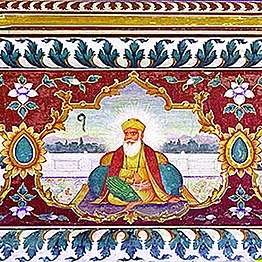
Nanak's teachings can be found in the Sikh scripture Guru Granth Sahib, as a collection of verses recorded in Gurmukhi.
There are two competing theories on Guru Nanak's teachings.[46] The first, according to Cole and Sambhi (1995, 1997), based on the hagiographical Janamsakhis,[47] states that Nanak's teachings and Sikhism were revelations from God, and not a social protest movement, nor an attempt to reconcile Hinduism and Islam in the 15th century.[48]
The other theory states that Nanak was a Guru, not a prophet. According to Singha (2009):[49]
Sikhism does not subscribe to the theory of incarnation or the concept of prophet hood. But it has a pivotal concept of Guru. He is not an incarnation of God, not even a prophet. He is an illumined soul.
The hagiographical Janamsakhis were not written by Nanak, but by later followers without regard for historical accuracy, containing numerous legends and myths created to show respect for Nanak.[50] In Sikhism, the term revelation, as Cole and Sambhi clarify, is not limited to the teachings of Nanak. Rather, they include all Sikh Gurus, as well as the words of men and women from Nanak's past, present, and future, who possess divine knowledge intuitively through meditation. The Sikh revelations include the words of non-Sikh bhagats (Hindu devotees), some who lived and died before the birth of Nanak, and whose teachings are part of the Sikh scriptures.[51]
The Adi Granth and successive Sikh Gurus repeatedly emphasised, suggests Mandair (2013), that Sikhism is "not about hearing voices from God, but it is about changing the nature of the human mind, and anyone can achieve direct experience and spiritual perfection at any time."[46] Guru Nanak emphasised that all human beings can have direct access to God without rituals or priests.[21]
The concept of man as elaborated by Guru Nanak, states Mandair (2009), refines and negates the "monotheistic concept of self/God," where "monotheism becomes almost redundant in the movement and crossings of love."[52] The goal of man, taught the Sikh Gurus, is to end all dualities of "self and other, I and not-I," attaining the "attendant balance of separation-fusion, self-other, action-inaction, attachment-detachment, in the course of daily life."[52]
Guru Nanak, and other Sikh Gurus emphasised bhakti ('love', 'devotion', or 'worship'), and taught that the spiritual life and secular householder life are intertwined.[53] In the Sikh perspective, the everyday world is part of an infinite reality, where increased spiritual awareness leads to increased and vibrant participation in the everyday world.[54] Guru Nanak described living an "active, creative, and practical life" of "truthfulness, fidelity, self-control and purity" as being higher than the metaphysical truth.[55]
Through popular tradition, Nanak's teaching is understood to be practised in three ways:[56]
- Vand Shhako (ਵੰਡ ਛਕੋ, 'share & consume'): Share with others, help those who are in need, so you may eat together;
- Kirat Karo ('work honestly'): Earn an honest living, without exploitation or fraud; and
- Naam Japo (ਨਾਮ ਜਪੋ, 'recite His name'): Meditate on God's name, so to feel His presence and control the five thieves of the human personality.
Legacy
Nanak is considered the founder of Sikhism.[57][58] The fundamental beliefs of Sikhism, articulated in the sacred scripture Guru Granth Sahib, include faith and meditation on the name of the one creator; unity of all humankind; engaging in selfless service, striving for social justice for the benefit and prosperity of all; and honest conduct and livelihood while living a householder's life.[59][60][61]
The Guru Granth Sahib is worshipped as the supreme authority of Sikhism and is considered the final and perpetual guru of Sikhism. As the first guru of Sikhism, Guru Nanak contributed a total of 974 hymns to the book.[62]
Influences
Many Sikhs believe that Guru Nanak's message was divinely revealed, as his own words in Guru Granth Sahib state that his teachings are as he has received them from the Creator Himself. The critical event of his life in Sultanpur, in which he returned after three days with enlightenment, also supports this belief.[63][64]
Many modern historians give weight to his teachings' linkage with the pre-existing bhakti,[65] sant,[lower-roman 5] and wali of South Asian/Islamic tradition.[66] Scholars state that in its origins, Guru Nanak and Sikhism were influenced by the nirguni ('formless God') tradition of the Bhakti movement in medieval India.[lower-roman 6] However, some historians do not see evidence of Sikhism as simply an extension of the Bhakti movement.[67][68] Sikhism, for instance, disagreed with some views of Bhakti saints Kabir and Ravidas.[67][69]
The roots of the Sikh tradition are perhaps in the sant-tradition of India whose ideology grew to become the Bhakti tradition.[lower-roman 7] Fenech (2014) suggests that:[66]
Indic mythology permeates the Sikh sacred canon, the Guru Granth Sahib and the secondary canon, the Dasam Granth and adds delicate nuance and substance to the sacred symbolic universe of the Sikhs of today and of their past ancestors.[lower-roman 8]
In the Bahá'í Faith
In a letter, dated 27 October 1985, to the National Spiritual Assembly of the Bahá'ís of India, the Universal House of Justice stated that Guru Nanak was endowed with a "saintly character" and that he was:[71]
…inspired to reconcile the religions of Hinduism and Islám, the followers of which religions had been in violent conflict.… The Bahá'ís thus view Guru Nanak as a 'saint of the highest order'.
See also
Notes
- Macauliffe (1909) notes that, according to the janamsakhi of Mani Singh, Nanak was married at the age of 14, not 18. "It is related in the Janamsakhi which bears the name of Mani Singh, that Nanak was married at the age of fourteen" (p. 18) Subsequent janamsakhis, however, claim that Nanak was married later, after he moved to Sultanpur (p. 29).
- "He was betrothed to Sulakhani, daughter of Mula, a resident of Batala in the present district of Gurdaspur." (Macauliffe 1909, p.19).
- "As a young man Nanak was married to Sulakhni, a daughter of Mula, a native of the newly founded town of Batala who had come there from his village, Pakho dī Randhawi, on the left bank of the river Ravi. Mula belonged to the subcaste Chona which was less important than even the subcaste Bedi.". (Grewal 1998, p. 6)
- Trumpp (1877) transliterates the names of Nanak's children from the Colebrooke janamsakhi as "Sirī-čand" and "Lakhmī-dās", rather than "Lakhmī-čand" (pp. iii, viii). Macauliffe (1909, p. 29) also gives their names as Sri Chand and Lakhmi Das.
- "In its earliest stage Sikhism was clearly a movement within the Hindu tradition; Nanak was raised a Hindu and eventually belonged to the Sant tradition of northern India." (McLeod 2019)
- "Historically, Sikh religion derives from this nirguni current of bhakti religion." (Lorenzen 1995, pp. 1–2)
- "Technically this would place the Sikh community's origins at a much further remove than 1469, perhaps to the dawning of the Sant movement, which possesses clear affinities to Guru Nanak's thought sometime in the tenth century. The predominant ideology of the Sant parampara in turn corresponds in many respects to the much wider devotional Bhakti tradition in northern India." (Fenech 2014, p. 35)
- "Few Sikhs would mention these Indic texts and ideologies in the same breadth as the Sikh tradition, let alone trace elements of their tradition to this chronological and ideological point, despite the fact that the Indic mythology permeates the Sikh sacred canon, the Guru Granth Sahib and the secondary canon, the Dasam Granth,[70] and adds delicate nuance and substance to the sacred symbolic universe of the Sikhs of today and of their past ancestors." (Fenech 2014, p. 36)
Citations
- Hayer 1988, p. 14.
- Sidhu 2009, p. 26.
- Khorana 1991, p. 214.
- Prasoon 2007.
- Search Gurbani.
- Singh 2006, pp. 12–13.
- Grewal 1998, p. 6.
- Gupta 1984, p. 49.
- Gupta 1984, p. 50.
- Gupta 1984, p. 54.
- Gupta 1984, p. 52.
- Gupta 1984, pp. 50–51.
- Gupta 1984, pp. 53–54.
- Gupta 1984, pp. 51–52.
- SGPC: Guru Nanak Sahib.
- Singha 2009a, p. 125.
- McLeod 2009, p. 86.
- Nankana: Rai Bular Bhatti.
- BBC: Religions 2011.
- Macauliffe 2004.
- Cunningham 1853, pp. 37–38.
- Singh 1984, p. 18.
- Singh 2000.
- Grewal 1998, p. 7.
- Macauliffe 2004, p. 19.
- Trumpp 1877.
- Cole & Sambhi 1978, p. 9.
- Grewal 1998, p. 8.
- Sikhs.org: First Master.
- Singh & Kapur 2004, p. 174.
- Dilgeer 2008.
- Johal 2011, pp. 125, note 1.
- Callewaert & Snell 1994, pp. 26–7.
- Lorenzen 1995.
- SikhiWiki 2013.
- Garg 2019.
- Gulati 2008, pp. 316–319.
- Lorenzen 1995, pp. 41–2.
- McLeod 2007, pp. 42–44.
- Ménage 1979, pp. 16–21.
- McLeod 2004, pp. 127–31.
- Oberoi 1994, p. 55.
- Callewaert & Snell 1994, pp. 27–30.
- Mandair 2013, pp. 131–34.
- Cole & Sambhi 1995, pp. 9–12.
- Cole & Sambhi 1997, p. 71.
- Singha 2009a, p. 104.
- Singh 2011, pp. 2–8.
- Cole & Sambhi 1995, pp. 46, 52–3, 95–6, 159.
- Mandair 2009, pp. 372–73.
- Nayar & Sandhu 2007, p. 106.
- Kaur 2004, p. 530.
- Marwha 2006, p. 205.
- McLeod 2009, pp. 139–40.
- Cole & Sambhi 1978, pp. 9–10.
- Moreno & Colino 2010, p. 207.
- Kalsi 2007, pp. 41–50.
- Cole & Sambhi 1995, p. 200.
- Teece 2004, p. 4.
- Shackle & Mandair 2013, pp. xviii–xix.
- Singh 1982, pp. 12, 18.
- "There is One God". The Hans India.
- Lorenzen 1995, pp. 1–2.
- Fenech 2014.
- Singha 2009b, p. 8.
- Grewal 1998, pp. 28–.
- Pruthi 2004, pp. 202–03.
- Rinehart 2011
- Sarwal 1996.
Bibliography
- "Bhai Gurdas Vaaran". Search Gurbani. Retrieved 1 December 2012.
- Callewaert, Winand M.; Snell, Rupert (1994). According to Tradition: Hagiographical Writing in India. Otto Harrassowitz Verlag. ISBN 978-3-447-03524-8.
- Cole, William Owen; Sambhi, Piara Singh (1978). The Sikhs: Their Religious Beliefs and Practices. London: Routledge & Kegan Paul. pp. 9–10. ISBN 0-7100-8842-6.
- Cole, William Owen; Sambhi, Piara Singh (1995) [First published 1978]. The Sikhs: Their Religious Beliefs and Practices. Sussex Academic Press. ISBN 978-189872313-4.
- Cole, William Owen; Sambhi, Piara Singh (1997). A Popular Dictionary of Sikhism: Sikh Religion and Philosophy). Taylor & Francis. p. 71. ISBN 0-203-98609-1.
- Cunningham, Joseph Davey (1853). A History of the Sikhs. London: John Murray. pp. 37–38.
- Dilgeer, Harjinder Singh (2008). Sikh Twareekh. Belgium: The Sikh University Press.
- Fenech, Louise E. (2014). Singh, P.; Fenech, L. E. (eds.). The Oxford Handbook of Sikh Studies. Oxford University Press. ISBN 978-019969930-8.
- "The First Master Guru Nanak (1469 - 1539)". Sikhs.org. Retrieved 9 August 2009.
- Garg, Abhinav (12 November 2019). "How Guru Nanak played a 'role' in Ayodhya verdict". The Times of India.
- Grewal, J. S. (1998) [First published 1990]. "The Sikhs of the Punjab". In Johnson, Gordon; Bayly, C. A.; Richards, John F. (eds.). The New Cambridge History of India (pbk ed.). Cambridge: Cambridge University Press. ISBN 978-0-521-63764-0.
- Gulati, Mahinder N. (2008). Comparative Religious And Philosophies: Anthropomorphlsm And Divinity. Atlantic Publishers. pp. 316–319. ISBN 978-81-269-0902-5.
- Gupta, Hari Ram (1984). History of the Sikhs: The Sikh Gurus, 1469-1708. Munshiram Manoharlal. ISBN 978-81-215-0276-4.
- "Gurdwaras in Bangladesh". SikhiWiki. 17 June 2013.
- "Guru Nanak Sahib | Ten Gurus". Amritsar: SGPC. Archived from the original on 18 February 2012. Retrieved 9 August 2009.
- Hayer, Tara (1988). Economic History of Sikhs: Sikh Impact. Volume 1. Surrey, BC: Indo-Canadian Publishers. p. 14.
- Johal, Jagbir (2011). Sikhism Today. Bloomsbury Academic. p. 125, note 1. ISBN 978-1-84706-272-7.
- Kalsi, Sewa Singh (2007) [First published 1999]. Sikhism. Simple Guides. pp. 41–50. ISBN 978-1-85733-436-4.
- Kaur, Nikky-Guninder Singh (2004). Sundararajan, K. R. (ed.). Hindu Spirituality: Postclassical and Modern. Motilal Banarsidass. p. 530. ISBN 81-208-1937-3.
- Khorana, Meena (1991). The Indian Subcontinent in Literature for Children and Young Adults: An Annotated Bibliography of English-language Books. Greenwood Publishing Group. p. 214. ISBN 978-0-313-25489-5.
- "The Legacy Of Rai Bular Bhatti". Nankana.com. Archived from the original on 16 June 2013. Retrieved 9 August 2009.
- Lorenzen, David N. (1995). Bhakti Religion in North India: Community Identity and Political Action. Albany: State University of New York Press. ISBN 978-0-7914-2025-6.
- Macauliffe, Max Arthur (1909). The Sikh Religion, Its Gurus, Sacred Writings and Authors. Volume 1. Oxford University Press.
- Macauliffe, Max Arthur (2004) [First published 1909]. The Sikh Religion – Its Gurus, Sacred Writings and Authors. India: Low Price Publications. ISBN 81-86142-31-2.
- Mandair, Arvind-Pal Singh (2009). Religion and the Specter of the West – Sikhism, India, Postcoloniality and the Politics of Translation. Columbia University Press. pp. 372–73. ISBN 978-0-231-14724-8.
- Mandair, Arvind-Pal Singh (2013). Sikhism: A Guide for the Perplexed. Bloomsbury Academic. pp. 131–34. ISBN 978-144110231-7.
- Marwha, Sonali Bhatt (2006). Colors of Truth, Religion Self and Emotions. New Delhi: Concept Publishing Company. p. 205. ISBN 81-8069-268-X.
- McLeod, W. H. (2004). Sikhs and Sikhism: Comprising Guru Nanak and the Sikh Religion, Early Sikh Tradition, The Evolution of the Sikh Community, Who is a Sikh?. Oxford University Press. pp. 127–31. ISBN 978-0-19-566892-6.
- McLeod, W. H. (2007). Essays in Sikh History, Tradition and Society. Oxford University Press. pp. 42–44. ISBN 978-0-19-568274-8.
- McLeod, W. H. (2009). The A to Z of Sikhism. Scarecrow Press. ISBN 978-0-8108-6828-1.
- McLeod, William Hewat (2019) [First published 1998]. "Sikhism". Encyclopædia Britannica.
- Ménage, V. L. (1979). "The "Gurū Nānak" Inscription at Baghdad". Journal of the Royal Asiatic Society of Great Britain and Ireland. Cambridge (1): 16–21. JSTOR 25210997.
- Moreno, Luis; Colino, César (2010). Diversity and Unity in Federal Countries. McGill Queen University Press. p. 207. ISBN 978-0-7735-9087-8.
- Nayar, Kamal Elizabeth; Sandhu, Jaswinder Singh (2007). The Socially Involved Renunciate – Guru Nanaks Discourse to Nath Yogi's. New York: State University of New York Press. p. 106. ISBN 978-0-7914-7950-6.
- Oberoi, Harjot (1994). The Construction of Religious Boundaries: Culture, Identity, and Diversity in the Sikh Tradition. University of Chicago Press. p. 55. ISBN 978-0-226-61593-6.
- Prasoon, Shrikant (2007). Knowing Guru Nanak. Pustak Mahal. ISBN 978-81-223-0980-5.
- Pruthi, R. K. (2004). Sikhism and Indian Civilization. New Delhi: Discovery Publishing House. pp. 202–03. ISBN 978-81-7141-879-4.
- Sarwal, Anil (1996). "Guru Nanak and Miracles". Miracles in Religion: A Study of the miraculous in religion in context of the Bahá'í Faith. Lucknow: Royale Publishers.
- Shackle, Christopher; Mandair, Arvind (2013). Teachings of the Sikh Gurus: Selections from the Sikh Scriptures. Routledge. pp. xviii–xix. ISBN 978-1-136-45108-9.
- Sidhu, Dawinder (2009). Civil Rights in Wartime: The Post-9/11 Sikh Experience. Ashgate Publishing. p. 26. ISBN 978-1-4094-9691-5.
- "Sikhism: Guru Nanak". BBC. 7 October 2011.
- Singh, H. S. (2000). The Encyclopedia of Sikhism. Hemkunt Press. ISBN 978-81-7010-301-1.
- Singh, Harbans (1982). Berkeley Lectures on Sikhism. Berkley: University of California. pp. 12, 18. ISBN 978-817304067-2.
- Singh, Kartar (1984). Life Story Of Nanak. New Delhi: Hemkunt Press. p. 18. ISBN 978-81-7010-162-8.
- Singh, Khushwant (2006). The Illustrated History of the Sikhs. India: Oxford University Press. pp. 12–13. ISBN 0-19-567747-1.
- Singh, Kirapala; Kapur, Prithipala (2004). Janamsakhi tradition: an analytical study. Singh Brothers. p. 174.
- Singh, Nikky-Guninder Kaur (2011). Sikhism: An Introduction. I. B. Tauris. pp. 2–8. ISBN 978-184885321-8.
- Singha, H. S. (2009a) [First published 2000]. The Encyclopedia of Sikhism. New Delhi: Hemkunt Publishers. p. 104. ISBN 978-81-7010-301-1.
- Singha, H. S. (2009b). Sikhism: A Complete Introduction. New Delhi: Hemkunt Press. p. 8. ISBN 978-81-7010-245-8.
- Teece, Geoff (2004). Sikhism: Religion in Focus. Black Rabbit Books. p. 4. ISBN 978-1-58340-469-0.
- Trumpp, Ernest (1877). Adi Granth, or The Holy Scriptures Of The Sikhs; translated from the original Gurmukhī. London: W. H. Allen & Co. and N. Trübner – via Internet Archive.
External links and Further reading
- Singh, Sahib. Guru Nanak Dev and His Teachings.
| Wikiquote has quotations related to: Guru Nanak |
| Preceded by — |
Sikh Guru 20 August 1507 – 7 September 1539 |
Succeeded by Guru Angad |
